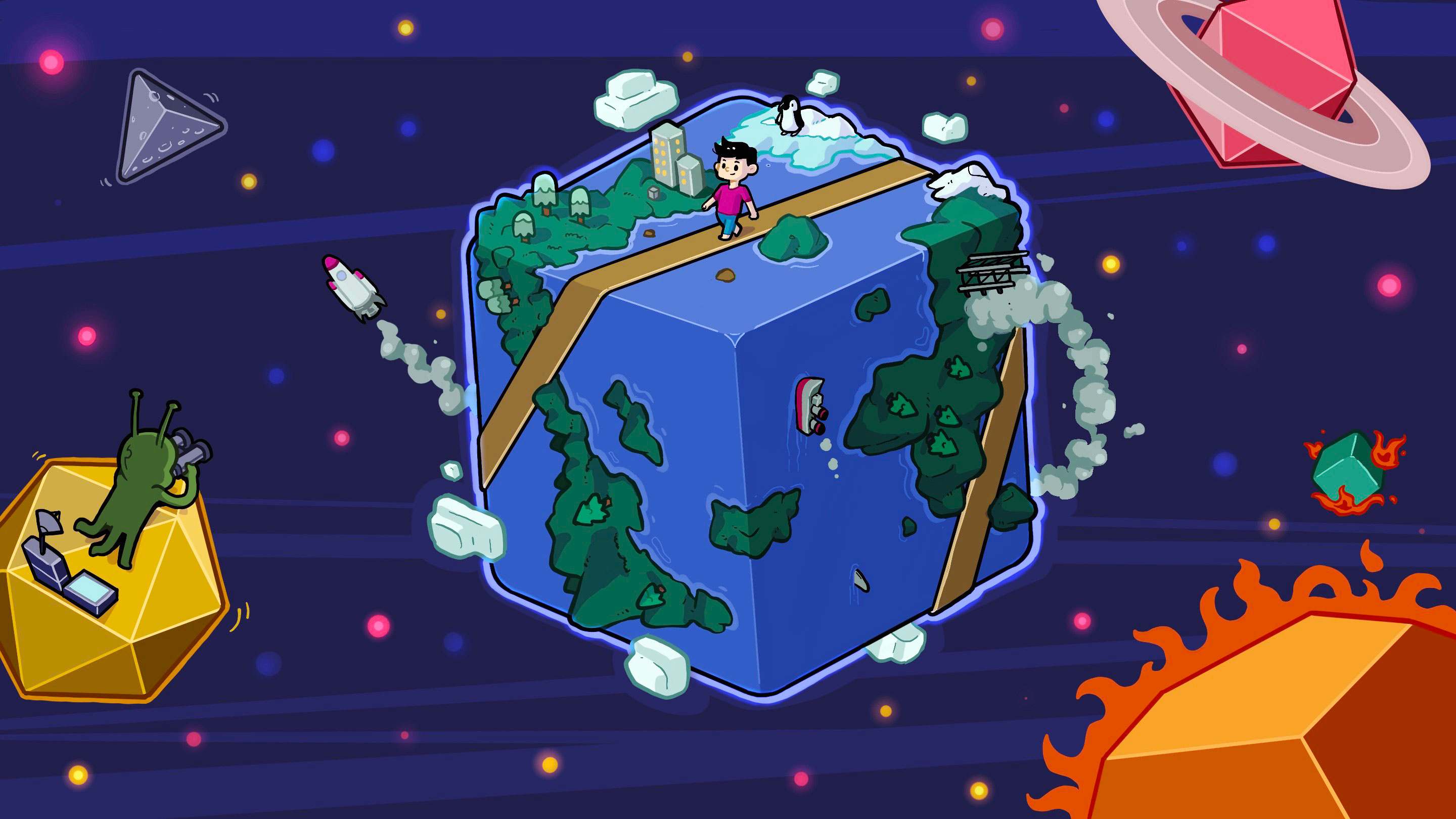The Crooked Geometry of Round Trips

BIG MOUTH for Quanta Magazine
Introduction
Have you ever wondered what life would be like if Earth weren’t shaped like a sphere? We take for granted the smooth ride through the solar system and the seamless sunsets afforded by the planet’s rotational symmetry. A round Earth also makes it easy to figure out the fastest way to get from point A to point B: Just travel along the circle that goes through those two points and cuts the sphere in half. We use these shortest paths, called geodesics, to plan airplane routes and satellite orbits.
But what if we lived on a cube instead? Our world would wobble more, our horizons would be crooked, and our shortest paths would be harder to find. You might not spend much time imagining life on a cube, but mathematicians do: They study what travel looks like on all kinds of different shapes. And a recent discovery about round trips on a dodecahedron has changed the way we view an object we’ve been looking at for thousands of years.
Finding the shortest round trip on a given shape might seem as simple as picking a direction and walking in a straight line. Eventually you’ll end up back where you started, right? Well, it depends on the shape you’re walking on. If it’s a sphere, yes. (And, yes, we’re ignoring the fact that the Earth isn’t a perfect sphere and its surface isn’t exactly smooth.) On a sphere, straight paths follow “great circles,” which are geodesics like the equator. If you walk around the equator, after about 25,000 miles you’ll come full circle and end up right back where you started.
On a cubic world, geodesics are less obvious. Finding a straight path on a single face is easy, since each face is flat. But if you were walking around a cubic world, how would you continue to go “straight” when you reached an edge?
There’s a fun old math problem that illustrates the answer to our question. Imagine an ant on one corner of a cube who wants to get to the opposite corner. What’s the shortest path on the surface of the cube to get from A to B?
You could imagine lots of different paths for the ant to take.
Samuel Velasco/Quanta Magazine
But which is the shortest? There’s an ingenious technique for solving the problem. We flatten out the cube!
If the cube were made of paper, you could cut along the edges and flatten it out to get a “net” like this.
In this flat world, the shortest path from A to B is easy to find: Just draw a straight line between them.
To see what our cube-world geodesic looks like, just put the cube back together. Here’s our shortest path.
Flattening out the cube works because each face of the cube is itself flat, so nothing gets distorted as we unfold along the edges. (A similar attempt to “unfold” a sphere like this wouldn’t work, as we can’t flatten out a sphere without distorting it.)
Now that we have a sense of what straight paths look like on a cube, let’s revisit the question of whether we can walk along any straight path and eventually end up back where we started. Unlike on the sphere, not every straight path makes a round trip on a cube.
But round trips do exist — with a catch. Notice that the ant could continue along the path we mapped out above and end up back where it started. On a cube, coming full circle produces a path that looks more like a rhombus.
In following this round-trip path, the ant has to pass through another vertex (point B) before returning to its starting point. That’s the catch: Every straight path that starts and ends on the same vertex must pass through another vertex of the cube.
This turns out to be true for four of the five Platonic solids. On the cube, tetrahedron, octahedron and icosahedron, any straight path that starts and ends on the same vertex must pass through some other vertex along the way. Mathematicians proved this five years ago, but the dodecahedron wasn’t on their list. We’ll return to that later.
To get a sense of why this fact about geodesics is true on four of the five Platonic solids, we’ll take a “tumbling” approach to these paths, and we’ll switch over to a tetrahedral world where tumbling paths are a little easier to study.
Imagine starting from a vertex of a tetrahedron and heading out on a straight path along a face. Let’s orient our tetrahedron so that our path starts on the bottom face.
When we meet an edge, we will roll the tetrahedron over, so that our path continues on the face that ends up on the bottom:
This tumbling diagram gives us a way to track our path just as we did on the net of the cube:
The tumbling path above represents this path on the surface of the tetrahedron:
Here the five tumbles of the tetrahedron correspond to the additional five faces traversed by the path.
Now we can imagine any path on the surface of the tetrahedron as a path in this tumbling space. Let’s call our starting point A and see where this point ends up after some tumbling.
As our path leaves from A, the tetrahedron tumbles over the opposite side. This lifts A off the ground.
Vertex A is temporarily suspended above our tumbling space. We wouldn’t normally indicate A’s location when creating our tumbling space, but here’s where it would appear if we were looking down.
As the path continues, the tetrahedron tumbles again. There are two directions it could go, but either way A ends up back on the ground.
As we let the tetrahedron tumble away in every possible direction, we end up with a tumbling space that looks like this:
This creates a grid system because of the way the equilateral triangular faces of the tetrahedron fit together.
This grid system tells us two interesting things about our tumbling space. First, the points where vertices of the tetrahedron can land are all “lattice points,” or points with integer coordinates. That’s because one unit in our coordinate system is one edge length of our tetrahedron.
Second, take a look at where A can end up.
The coordinates of A are always even. Whenever A is on the ground, it will be back on the ground two tumbles later, so the possible landing spots for A are all spaced out by two edge lengths in each tumbling direction.
Now let’s see what this says about geodesics. Recall that a path on the tetrahedron that starts and ends at A will be a straight line segment in the tumbling space starting at the A at (0,0) and ending at another A. And when the starting and ending points of the path are both A’s, there’s something quite interesting about the midpoint of the path.
Even in our crooked coordinate system the standard midpoint formula still works, so we can find the coordinates of our midpoint by averaging the coordinates of the endpoints. Since the coordinates of the starting point are both 0 and the coordinates of the ending point are both even, the coordinates of our midpoint are both integers. This makes the midpoint a lattice point, and as we observed above, it therefore corresponds to a vertex of the triangle in the tumbling space.
For example, the path from (0,0) to (4,2) has midpoint (2,1), a lattice point in our grid.
That means that on the surface of the tetrahedron, this path from A to itself must pass through another vertex along the way.
Since every possible landing spot for A has even coordinates in this system, the midpoint of every geodesic path starting and ending at A will correspond to a lattice point. This shows that every geodesic from A to A on the surface of the tetrahedron must pass through another vertex.
This is a simple version of an argument that was made rigorous in 2015 by the mathematicians Diana Davis, Victor Dods, Cynthia Traub and Jed Yang. They used a similar but much more complicated argument to prove the same for the cube. Dmitry Fuchs proved the results for the octahedron and icosahedron the next year. Because of this, we know that for the tetrahedron, cube, octahedron and icosahedron, there are no straight paths going from a vertex back to itself that don’t pass through another vertex.
But the existence of such paths on the surface of the dodecahedron remained an open question until 2019, when the mathematicians Jayadev Athreya, David Aulicino and Patrick Hooper proved it was actually possible. In fact, they found infinitely many straight paths on the surface of the dodecahedron that start and end on the same vertex without passing through any others.
Here’s one shown on the net of the dodecahedron, hiding in plain sight.
For thousands of years the Platonic solids have been studied together because they have so much in common. But now we know something new about the dodecahedron that is decidedly different. This mysterious discovery shows that no matter how well we understand mathematical objects, there’s always more to learn. It also shows that the path from problem to solution won’t always look like a straight line.
Exercises
1. If the cube has edge length 1, how long is the ant’s shortest path from vertex to opposing vertex?
2. Explain why the diagram below could not be the tumbling path for a path on the cube.
3. One complication with tumbling paths of the cube is that point A doesn’t have a unique end position associated with a given ending location of the cube. For example, even though the cube ends up in the same location tumbling along either the red path or the blue one, point A ends up in different positions. Determine where A ends up after tumbling along the red path and the blue path.
4. Here’s a valid tumbling path for a path on the cube.
Sketch the path on the surface of a cube starting at A.
Answers
Click for Answer 1:
Click for Answer 2:
Click for Answer 3:
Click for Answer 4:
Correction: January 13, 2021
This column was revised to make clear that the five tumbles of the tetrahedron shown correspond to the five "additional" faces traversed by the path, as the path traverses six faces in total.
This article was reprinted on Wired.com.



